All fields are required
Posted in E. coli,Our Blog on November 24, 2024

A new study on E. coli and climate change highlights the impacts the problem has on foodborne outbreaks. Specifically, the most scary of E. coli bacterial strain. Shiga toxin-producing Escherichia coli O157:H7 or STEC O157:H7.
Why is this important?
Increased rainfall and flooding potentially carrying these bacteria onto crops contribute to foodborne illness outbreaks.
Here’s what we know about the study on E. coli and climate change as well as what you can do at home to reduce your risk.
Research published in Eurosurveillance called “An outbreak of Shiga toxin-producing Escherichia coli (STEC) O157:H7 associated with contaminated lettuce and the cascading risks from climate change, the United Kingdom, August to September 2022.”
Now isn’t that a mouthful!
The title gives you a good idea about what kind of data they were looking at.
But why investigate E. coli and climate change in this study?
The impacts of E. coli outbreaks are severe.
According to reports, 30% of STEC cases in the European Union require hospitalization. About 5% of those with STEC infections will develop a life-threatening type of kidney failure called hemolytic uremic syndrome. This statistic jumps to 11% in children under five years old.
During the study period, STEC was the third most commonly notified foodborne pathogen in the European Union (across the 29 countries reporting data).
This amounted to 8,565 confirmed cases of STEC infection and 71 foodborne STEC outbreaks across 14 countries. And this only accounts for those that are confirmed. The true number of illnesses is likely much higher, as many people experience milder symptoms and do not seek medical care. Those people are never tested for E. coli and are not included in reported statistics.
There are many different strains of E. coli. Most of them cause no issues to humans at all. In fact, many strains of E. coli are a normal part of our digestive system.
There are, however, some seriously harmful strains. Namely, STEC strains.
These STEC bacteria often reside within the gastrointestinal tract of cattle and sheep, making them the primary source for most foodborne outbreaks in the European Union.
But wait…
I thought we were talking about lettuce and other crops.
How do we make the leap between sheep and cattle and lettuce?
According to the study, food items contaminated with the germ are the primary source of foodborne STEC O157 outbreaks.
This can involve raw or undercooked beef or lamb meat products or unpasteurized dairy products. But this study is focusing on the crop aspect.
This happens when rainwater run-off, floodwater, or irrigation water containing animal feces comes into contact with crops.
Many E. coli outbreaks occur on a seasonal basis.
But many crops are only grown seasonally. That isn’t a very strong correlation.
There is, however, a correlation between higher pathogen load detected in floodwater after rainstorms and heavy precipitation followed by flooding of animal environments.
The E. coli bacteria is a microscopic germ so small that you cannot see it with your own eyes. Microscopes are needed to visually see them and complicated laboratory tests are required to analyze them for specific strains. Contaminated food generally does not look, smell, or taste any differently.
Anyone can become sick with an E. coli bacterial infection if they consume food contaminated with the germ or eat or drink after coming into contact with it. However, some people are at greater risk of becoming sick if exposed and experiencing serious illness if infected.
These people include:
The symptoms of E. coli infections vary based on the strain of E. coli bacteria causing the illness. Some illnesses may be mild, while other may be serious or life-threatening.
Common symptoms include:
Most of the time people do not need medical attention to recover from E. coli infections. However, always seek medical care for severe symptoms.
Call your healthcare provider if you have:
The study suggests options farms and investigators can take to prevent and investigate foodborne illness. However, there are simple things you can do at home to reduce your own risk.
The study suggests using weather monitoring as part of pathogen prevention protocols.
“In the future, proactive utilization of real-time weather monitoring data could be used by risk assessors and risk managers to identify farms experiencing adverse weather event that could result in amplification of risk, to enhance pre- and post-harvest risk mitigation measures (such as microbiological testing).”
Increasing testing activities or pathogen mediation activities following adverse weather may reduce the risk of E. coli outbreaks.
At home, simply washing your fruits and vegetables can reduce the risk of E. coli infection. Scrub heavier skinned vegetables or place under running water to remove potential germs lurking on your leafy greens, fruits, and vegetables.
Even if you do not intend to eat the rind, wash those fruits and vegetables too. Think melons, avocado, and kiwi. When you cut produce, the knife can drag harmful germs through the fruit of the item and contaminate it.
If you’d like to know more about food safety topics in the news, like “New Study on E. coli and Climate Change Highlights Impact on Foodborne Outbreaks,” check out the Make Food Safe Blog. We regularly update trending topics, foodborne infections in the news, recalls, and more! Stay tuned for quality information to help keep your family safe, while The Lange Law Firm, PLLC strives to Make Food Safe!
By: Heather Van Tassell (contributing writer, non-lawyer)